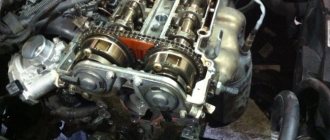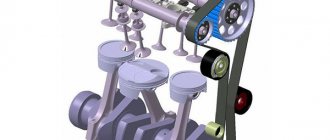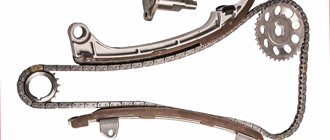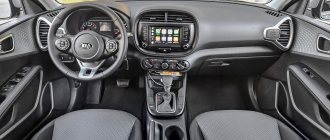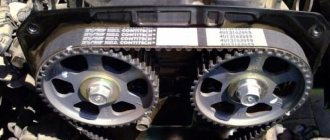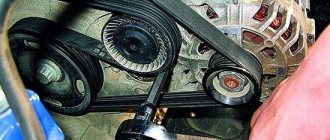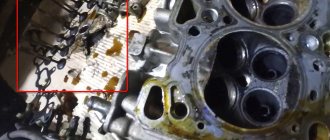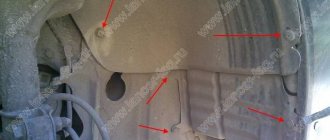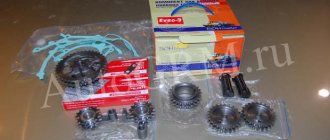Technical characteristics and design
The larger the engine capacity, the more powerful the car, and, as a rule, the larger it is. There is no point in installing a small-capacity engine on a large car, the engine simply cannot cope with its weight, and the opposite is also pointless - installing a large engine in a light car. Therefore, manufacturers are trying to select a motor. The more expensive and prestigious the model, the larger the engine capacity and the more powerful it is. Budget versions rarely boast a cubic capacity of more than two liters.
G4FC Engine Characteristics
The G4FC engine, belonging to the GAMMA series of Hyundai, has been serially installed on Hyundai/Kia cars since 2007. This in-line petrol four with overhead camshafts is made according to the now classic DOHC design. Camshafts located in the cylinder head control the operation of 16 valves.
It differs from the G4FA only in the crankshaft with an increased piston stroke from 75 mm to 85.4 mm, otherwise the engines are like two peas in a pod, still the same variable valve timing system on one shaft, timing chain.
In addition, this engine has a Gamma II version with a variable valve timing system on both camshafts; such engines are more powerful and develop 128-130 hp.
G4GC Engine Characteristics
The Kia Soul G4GC engine is made of aluminum. Lightweight block covered with a 16-valve head. The SHPG and combustion chamber, a different cylinder head gasket and the head itself, engine mounts, and a catalyst were changed.
Soul engines are equipped with a variable valve timing system on the intake shaft CVVT, but are not equipped with hydraulic compensators; the engine requires adjustment of valve clearances every 90 thousand km.
The timing belt is driven by a belt, and to avoid breakage, bent valves and other goodies, you need to change the belt and rollers every 60 thousand km. Again, many people drive more than 100 thousand km on one belt, but such savings, sooner or later, will backfire.
Technical characteristics of the Kia Soul G4GC engine:
Source
Exterior
A review of the car must begin with the fact that the usual lines and relationships remain the same as they were in the previous modification of the car. The body dimensions have increased slightly, thanks to which the designers have achieved a more modern appearance, as well as operational advantages of the car.
The front part began to look more weighty and brave, thanks to the use of new head optics. The headlights are connected into common blocks, which are complemented by lines of daytime running lights, which are highlighted by LED filling. The appearance was also improved thanks to the transformation of the front bumper, which began to be equipped with a more evil air duct, reminiscent of the mouth of a predator. The fog lights are quite large, which adds to the aggressiveness of the car. The bumper also houses a massive aerodynamic lip. Pneumatic supports allow you to open the hood without much difficulty.
The side of the car also underwent changes in the form of a large rear door opening. This gave the roof and stern pillar a more powerful appearance. The wheel arches along with the door surfaces also became more inflated. This creates the impression that the car is “unpowered”, since its appearance seems to hint at power.
The ground clearance of the 2021 Kia Soul is 165 millimeters, which is quite enough for comfortable movement. 16-18 inch light alloy wheels are used as “slippers”. The color range available for customers to choose as the main one for the body has also been significantly expanded. Manufacturers have added 3 new colors, among which black, yellow and red stand out (the last two are very bright).
On the rear of the car there are new optics pillars, which very well emphasize the vertical image of the rear part and fit into the overall concept of the car. In addition, the car has a small tailgate and a fairly powerful bumper. The design is very well combined with the front part. Swift and attractive appearance is what this car is famous for.
The dimensions of the new modification are as follows: the length is 4140 millimeters, and the width of the body is 1800 millimeters. The height of the car is 1593 millimeters, and if you take into account the roof rails - 1605 millimeters. Of the total length, 2570 millimeters are allocated to the wheelbase. When equipped, the second generation Soul can weigh from 1282 to 1406 kilograms. Weight is directly affected by vehicle modification.
Interior
The Soul salon was approached with special responsibility, and everything was done in the brand’s corporate style. This resulted in some similarities with other models of the Korean manufacturer, but with certain inclusions of original solutions. Directly in front of the driver is a fairly large steering wheel, which houses a large number of different controls. In rich trim levels there is also a heated steering wheel. Two options can be used as a dashboard: in cheap trim levels there are instrument dials that are hidden in separate wells, and in more expensive versions the Supervision dashboard is installed, distinguished by dials in a strict design and a 4.3-inch diagonal display.
The appearance of the center console is quite fresh and attractive. In a sense, this was achieved due to the fact that the design looks “varnished”. The console houses a standard audio playback system, which in richer trim levels is replaced by an 8-inch monitor. The climate system control unit is also located there, made in the original design, since it has an interesting round monitor (monochrome).
Soft plastic is mainly used as the main materials for the interior, which is diluted with glossy decor and silver inserts. The seats can be trimmed with high-quality fabric or genuine leather.
Motors
Only three engine variations were installed on the car:
The first option is a four-cylinder diesel power unit, on which an additional supercharger in the form of a turbine is installed. Its working volume is 1.6 liters and it has 16 valves. The average fuel consumption of a Kia Soul with a 1.6 engine is about 5.6 - 6 liters of high-quality diesel fuel per 100 kilometers traveled. The maximum power developed by the power unit is 136 horsepower, and the peak torque is 300 Nm, which is achieved at 2.5 thousand rpm.
The Korean D4FB engine is quite reliable and can function normally for 300 thousand kilometers without causing any difficulties to the owners. But it is necessary to pour only high-quality diesel fuel into the engine, otherwise you can get a large number of problems, since it is quite demanding on the quality of diesel. Loading the engine in cold weather without proper warming up is highly not recommended. The main problems of the Kia Soul with such an engine under the hood are related to the noise of the timing chain. The problem often occurs after 120 thousand kilometers, so it is almost impossible to avoid it. Problems can be resolved by adjusting the tension roller. You can easily do this even yourself. There are also no special complaints about the attachments, since they last a long time, and for the first 150 thousand kilometers there will be no problems with them.
The next power unit is the G4NA, which belongs to the modernized Theta 2 family. It is based on the ordinary G4KD engine, which does not have any particular disadvantages. The cylinder block and cylinder head of this engine are cast from aluminum. Kia Soul with such a 2.0-liter engine is distinguished by steel cylinder liners, but they cannot be installed independently, since they have very thin walls. Many people wonder if a chain or belt is installed on this engine as a timing drive, but the answer is clear - a chain. 16 valves are arranged according to the DOCH system and are adjusted automatically thanks to the installation of hydraulic compensators. This engine has MPI distributed injection.
Its displacement is 2 liters and the maximum power is 167 horsepower, but the Kia Soul 2.0 with 150 hp is supplied to the Russian market (that is, the software is somewhat “strangled”). This is an in-line four-cylinder engine, the power supply system of which is arranged using an injector. The maximum torque is 201 Nm and develops at 4.2 rpm. 150 horsepower develops without a turbine.
Owner reviews of the Kia Soul 2021 indicate major shortcomings of this engine. The inner walls of the cylinders are very thin, so scuffs form on them after 20 thousand mileage. You need to know what kind of oil to pour into the Kia Soul 2.0, since the engine is sensitive to the quality of the lubricant, which leads to many problems. The engine handles 5W-20 best. It is impossible to repair an aluminum block, so it is considered the weakest point of such a motor. But this does not end the description of all the characteristic malfunctions. Under the valve cover, oil pressure may spontaneously and unexpectedly increase. It is impossible to repair the crankshaft, since it cannot be restored. If the connecting rod bearings turn, you will have to buy them together with the connecting rods, since they are not supplied separately. And the volume of two liters is too much for such power.
Next comes the new Kia Soul 2021, the characteristics of which are provided by the 1.6 gdi engine. This is the first engine that received direct fuel injection, naturally among analogues. This is an in-line four-cylinder power unit that is capable of developing 132 hp, and its turbocharged version develops up to 138 horses and it comes only with a manual transmission. But 132 horses are enough to ensure normal dynamics of a small car, as evidenced by the test drive of the new 2021 Kia Soul. Features include the fact that the BC and cylinder head are made of 80 percent aluminum. There is an injector for direct fuel injection GDI. A pair of camshafts are arranged according to the classic DOHC system. The gas distribution mechanism is driven by a chain and works together with a tensioner and damper. CVVT phase regulators are installed. The maximum torque is 192 Nm.
The Kia Soul 1.6 gasoline engine has characteristic problems, such as extraneous noise and knocking noises that come from under the hood of the car. A similar phenomenon is usually noticed on a cold engine, and disappears after reaching operating temperature. This malfunction is caused by poorly adjusted valves or a loose timing chain. The engine may leak oil, which can be eliminated by replacing the seals in those places where this problem occurs. Owners may encounter failures in idle mode; here they will have to adjust the settings of the injection system or gas distribution mechanism. Increased vibration levels are also eliminated by adjusting the timing belt.
The question of choosing between 1.6 GDI or 2.0 MPI is a very popular question among users. Definitely, the first option will be better, since their power is not very different, and the reliability of 1.6 is much greater. And it’s cheaper to maintain this power unit, and in some cases you can do it yourself.
How's it going?
If you are not a traffic light racer, the base 1.6 engine (123 hp) will be enough, especially in the version with a manual gearbox. With an automatic transmission, this Soul is slower in accelerating to hundreds by 0.8 s (12.0 s). Both gearboxes are six-speed, reliable and convenient. Version 2.0 is sold only with an automatic transmission and is obviously faster (10.2 s to 100 km/h), but where to realize the potential of the engine? In a city hung with cameras, so many “horses” are useful only to amuse one’s vanity. But if you often drive on the highway, and even with a full load, then two liters is preferable.
Restyling
Restyling of the Kia Soul took place in August 2021, and sales on the European market began a little later. So what is the difference from pre-restyling? In almost everything: the car received updated bumpers and grille, as well as redesigned lighting equipment. Several colors have been added to the body color palette. The new model began to be supplied in the Style Up package, which featured original wheels and a red stripe on the sills. The differences in this version in the interior can be seen on the dashboard. Almost no other changes were found. Only the steering wheel on cars with an automatic transmission began to place buttons for switching gearbox operating modes. An upgraded multimedia system was also installed.
But the changes affected not only appearance. Soul received a completely retuned steering and suspension. The gearbox has also undergone modernization. A 1.6-liter engine with a turbine was added to the line of power units, which produced 204 horses and was paired with an automatic transmission. A modification with such an engine was called KIA Soul GT. The braking system has also been strengthened.
Which one is more reliable?
Luxe cars have 17‑inch wheels and 215/55 R17 tires.
This is the best option. 18‑inch wheels (235/45 R18) on top versions, you need to be careful with them on bad roads. Luxe cars have 17‑inch wheels and 215/55 R17 tires. This is the best option. 18‑inch wheels (235/45 R18) on top versions, you need to be careful with them on bad roads.
The younger motor belongs to the Gamma family. Valve adjustment (there are no hydraulic lash compensators) needs to be done every 90,000 km, but the experience of owners shows that the need usually occurs less frequently. The two-liter engine from the Nu series has hydraulic compensators - minus one maintenance procedure.
However, the costs for the first ten maintenance (which is 150,000 km) are almost equal: the owner of a 1.6-liter car with an automatic transmission will have to pay 88,287 rubles, and the buyer of a two-liter car will have to pay 86,783 rubles. The reason is that spark plugs on a less powerful Soul need to be changed every 60,000 km versus 150,000 km. The two-liter model requires more durable iridium ones.
Both engines have a timing chain drive. For a 1.6-liter it will easily last 150,000–200,000 km with good oil, timely replacement and a calm driving style. The two-liter one has a slightly shorter lifespan due to the high dynamic loads experienced by the chain. But against the general background, the timing drive resource is very good. The result is parity.
Options
In the basic Classic configuration, the car has a large number of all the necessary functions, among which you can find ABS and ESP for safety. For greater comfort, air conditioning is installed, as well as an on-board computer. The driver is given the opportunity to adjust the steering wheel for reach and height. All four windows are electrically operated. The steering wheel, front seats and mirrors are heated, as is the wiper area. The side rear view mirrors are electrically operated.
The Kia Soul comfort package includes everything that is included in the classic version, but in addition, owners receive climate control, a rear view camera, a light sensor, fog lights and light alloy wheels..
The Kia Soul Luxury package includes the installation of six airbags, a stabilization system, rear parking sensors, as well as everything that is included in the comfort package.
The prestige package of the Kia Soul is complemented by electric adjustments for the driver's seat, a rain sensor, a keyless entry system, roof rails and front parking sensors. This is the maximum configuration of the Kia Soul.
Source
Weaknesses of Kia Soul:
Nothing is perfect, and even the coolest car is not without a few flaws. A cute crossover can also create a certain amount of problems.
Making the roof pillars so massive is an interesting solution, but it makes rear and side visibility very difficult. Despite this, the dimensions of the crossover feel great. During the peak of sales, the manufacturer offered, for an additional fee, the installation of a camera to replace the rear view mirror.
The main problem with the Kia Soul. Apparently, by making the suspension stiffer, the manufacturers hoped to make Soul an athlete, but the implementation didn’t work out very well. A rigid suspension may not provide sufficient body support. The steering system also suffers, which is not at all conducive to energetic driving: the crossover begins to yaw when quickly passing uneven surfaces, and there are quite a lot of them on the roads of our country.
Perhaps the manufacturer expected that the dense chassis and large-diameter wheels would provide good traction. However, in the conditions of Russian realities, a rigid suspension only causes inconvenience.
For those who value comfort above all else, we can give this advice: use wheels of size 205/55 R16. They absorb most of the unevenness, whereas in expensive versions this effect is not observed.
Not such a serious problem, since the failures are quite minor, but can be annoying during daily use of the car. By the way, they are the ones that cause a lot of problems with the steering, power windows, central locking and audio system. Also, sometimes the headlight LEDs burn out.
Car owners often complain about too rapid wear of the brake system, as well as the fragility of the wheel bearings. Of course, most of the components and assemblies of the Kia Soul can be replaced, but dealer prices are often not affordable.
This drawback can also be attributed to the finishing of the car. Of course, we should pay tribute to the quality of the interior elements, but the first minor damage appears on the plastic inside the cabin after a couple of years. Small pockets of corrosion quickly appear along the edges of the body, as well as on chassis elements. Rust also attacks sheet metal tailgates. This is usually corrected at official car repair shops under warranty.
The varnish on the body is also susceptible to chips and scratches, so frequent use of a car wash and cheap car coating care products are contraindicated for the car.
No, theoretically, of course, it exists, but in practice it is not possible to find it. You can verify this by opening the fifth door. The declared volume is 220 liters, with the rear seats folded down it increases to 700, but even in this form it does not become particularly spacious. Many drivers are very upset by this circumstance, but nothing can be done - it’s a whim of the manufacturer.
The most common breakdowns and defects of the Kia Soul:
In addition, sometimes, as the mileage increases, various parts of the car may fail. All claims should be addressed to official warranty dealerships.
However, the serviceability of car components often depends on the owner and operating conditions.
The main disadvantages of the Kia Soul:
The Kia Soul is not the cheapest car model. It arose in the market when the consumer considered all offers extremely carefully and, after much deliberation, made a purchasing decision. The Kia Soul was an unusual, stylish and practical car option. What other manufacturers charged extra for was included in the Kia Soul as standard.
The car will cost you 830,000 rubles. If you take it with mileage - about 500,000-600,000 rubles.
Fuel consumption depends on the type of diesel engine selected. As we remember, you can choose from three options offered by the manufacturer.
So is this crossover worth buying?
The model still looks stylish and interesting today. Like any vehicle, the Kia Soul has its pros and cons. Owner reviews agree on one thing - the car is comfortable, beautiful, functional, but has several significant shortcomings. Users also speak positively about the handling and maneuverability of the crossover.
PS: Dear car owners, if you have identified systematic breakdowns of any components or parts of this car model, please report them in the comments below. We will jointly keep statistics on frequent malfunctions and shortcomings.
MORE USEFUL AND INTERESTING ABOUT CARS:
18 messages to the article “Weaknesses and main disadvantages of the used Kia Soul”
))) for a comfortable ride 205/55 R16. I recommend 205/60 R16, I myself drive the kind that is softer than the 55 profile, I think you can stick a 65 profile
Have you already set it to 215/65/16?
Hello, you need to check the start-stop system and the wires going to it. It seems the system does not see that the engine is running
I forgot to say - the starter works on the Kia Soul 2010. 1.4 l.
Similar situation. Tell me how you solved the problem?
Kind! Malida, I’ve never seen anything like this, maybe it exists, but there’s a bang after releasing the brake!! Press the gas + brake pedals at the same time. This shouldn’t happen; if it does, what technical explanation does the service give?
Svetlana, it’s strange, it’s better to undergo a small maintenance in advance than to overpay later for the repair of something more expensive!
Good afternoon! Soul 2011 1.6 automatic transmission... The situation is as follows... 4th gear freezes... and when accelerating I want to engage 3rd speed... I also think this is really an adaptive gearbox or a breakdown?
My problem was solved. They drove it to a service center for 5 days and burned a tank of gasoline. But we still got the result: when switching from 2 to 3 speed, there is a failure... We found a broken wire (I can’t explain which one, I don’t understand), but after replacing it, the car flew like it was in 1 year of operation... the adaptive box was definitely not to blame, ...this is a malfunction. I advise you to contact the service.
During the 1st year of purchase, traction disappeared when I pressed the gas. The automatic transmission switches to 3rd gear and that’s it. Acceleration to 60 km per hour and that’s it. Sul 2021 1.6 automatic mileage 12000 km
For those who don’t know, the stiffer the suspension, the higher the tire profile height should be for a more comfortable ride over potholes, and 205x55x16 for roads with ideal surfaces.
The point is that the standard tires in the Prestige and higher configurations (I have one) are low-profile R18. All the holes on it are noticeably painful. And the basic configuration includes 205x60x16 tires. They have a much higher profile and are 2 times more comfortable when driving on our roads. But at the same time, this size is set by the manufacturer as standard, which means you can ride it safely. That's why brother's advice is these wheels. I took myself this size of winter wheels - earth and sky, compared to summer. 18-wheel drives look gorgeous - who can argue, but their practicality leaves much to be desired.
The new Kia has not failed even once in six months, one significant drawback is that the fastenings for the backs of the sofa rattle, it’s just trash!! The DC said it was a typical problem for them.
Soul 14. Has anyone encountered such a problem? At times (not constantly) the steering wheel slightly “bites” when moving in a straight line. It is when moving that everything is okay, i.e. the rack cannot be the cause. This kind of trouble started after the first maintenance. It was a sin to think that the electric amplifier had been replaced... The diagnostics revealed nothing. We rode with the technician from the DC three times, as luck would have it, the defect did not show up.
The Kia Soul model appeared on the automobile market in 2008. But since it was an innovation at that time, not everyone believed in grafting among consumers. But from the very first sale I liked the car. It was suitable for those who wished to become individual among other motorists and at the same time get a truly high-quality, compact, but roomy vehicle. This is exactly how the manufacturer from Korea presented it, giving it front-wheel drive, which for the Kia Soul tried to reduce to a minimum.
Kia Soul engines
The history of the Kia Soul model dates back 10 years ago - in 2008. It was then that the famous Korean automaker presented a new car at the Paris Motor Show. Sales of the car to European countries, as well as the Russian Federation and the CIS, began in 2009.
After a very short period of time, the car managed to win the hearts of many car enthusiasts, because “Soul” became the first “unlike other” cars. Already in the first year of production, this model received two awards:
This model is successful all over the world, there are several explanations for this:
One of the interesting facts about the Kia Soul is that it cannot be classified into any class of car. Some classify this model as a crossover, some as a station wagon or hatchback, while others believe that the Soul is a mini-SUV. There is also no specific positioning by segment, although many experts classify Soul as a “J” and “B” segment. There is no clear opinion on this matter.
Perhaps this was also one of the reasons for the popularity of the model, because it is not so often that a model with a “bold” design appears on the market without belonging to a certain class. Moreover, the audacity here refers more to the design approach, and not to the bizarre shapes of the car itself. It is unlikely that the same meticulous and conservative German automakers would have dared to make such a decision. The Koreans decided to take a risk and were right; one evidence of this is the long stay of this model on the Kia assembly line (as much as 10 years).
The closest competitors of the Kia Soul are the following car models: Ford Fusion, Skoda Yeti, Nissan Note, Nissan Juke, Suzuki SX4, Citroen C3, Mitsubishi ASX, Honda Jazz. Each of these models has similarities to the Soul, but the Soul does not have a direct competitor. Some are similar only in body, while having cramped interiors, others are crossovers that are in a completely different price range. So the Soul remains one of the most original cars of our time.
Kia Soul timing chain replacement
Timing chain replacement quickly and at a fair price! Come to us if you notice signs of chain wear:
We will promptly replace the timing chain, and, if necessary, engine oil and filter, diagnose the engine and gas distribution system.
FUNCTIONAL PURPOSE OF THE TIMING CHAIN
The Kia Soul timing chain drive is part of the gas distribution mechanism and is involved in the transmission of torque from the crankshaft to the camshaft. The chain can connect them directly or participate in the work indirectly, for example, combining camshafts with each other, if there are two of them, while its functional purpose remains unchanged.
Monitoring the condition of the timing chain, replacing dampers and tensioners is part of routine vehicle maintenance and plays an important role in the operation of the vehicle engine. It is necessary to regularly monitor the condition of the gas distribution system, as this directly affects the vehicle’s power, sensitivity when supplying gas and fuel consumption.
FEATURES OF CHAIN REPLACEMENT
In most engines of older car models, chains with roller links were used to transmit torque, often the components were in two or three rows, this made the timing chain a very reliable, almost eternal mechanism that does not require constant maintenance. Often the car traveled up to 300,000 km. and the chain of the mechanism received only lateral play, and the worst thing that could happen to the gas distribution mechanism was the links jumping; breaks were extremely rare. Over time, production price, efficiency, environmental friendliness and the weight of the car engine, which affects its power, have become trends in the creation of cars. Under these conditions, manufacturers began to strive to replace the timing chain with a lighter, cheaper and easier to maintain timing belt. And those motors whose design retained chains and roller components were replaced with lightweight plate links, more reliable than timing belts, but still not as strong as roller chains.
The Kia Soul timing chain has a number of features that fundamentally distinguish it from the timing belt.
1. The chain is a durable mechanism; it wears out much longer than the timing belt; breaks do occur, but much less frequently than in belt-driven engines.
2. A break in the timing chain occurs quite rarely, which means engine breakdowns requiring expensive overhauls do not occur often.
3. Timing chains are quite noisy, but with the modern level of car noise insulation, this parameter becomes not very important.
4. When the chain wears out, its play and lateral runout occur, this indicates the need to replace the old chain with a new one. Since the metal part sagging and lateral runout is accompanied by strong noise, it is simply impossible not to notice and not to attach significance to it. A noise under the hood will be the first “bell” indicating the need for vehicle maintenance.
5. The main disadvantage of replacing the Kia Soul timing chain is that it is located inside the cylinder block and it is quite difficult to assess its condition without training and experience. In addition, dismantling and replacement, with such a device, is a long and labor-intensive process, and therefore expensive.
6. The operation of the timing chain involves tensioners and dampers - these are consumable parts that wear out quickly and require more frequent replacements than the timing chain itself.
TYPES OF FAULTS
1. Timing chains, when in full working order, have a natural movement, which is compensated by tensioners when oil pressure is applied. A malfunction is considered to be a strong lateral runout of the timing chain, which appears when the links are stretched. The actual degree of chain stretch can only be determined through a qualified inspection of the gas distribution mechanism.
2. Backlash is a direct stretching of the chain, which is observed during long-term operation, can lead to jumping of chain links and malfunction of the gas distribution mechanism, this leads to a decrease in the sensitivity of the engine when the gas pedal is pressed and an increase in fuel consumption.
3. A broken Kia Soul timing chain is the most dangerous damage to the engine; in the case of a chain drive motor, it does not occur often, but it does occur. If such a malfunction occurs, the camshaft ceases to be connected to the crankshaft and can stop completely arbitrarily in a position in which any of the valves of the gas distribution mechanism is open. In this case, the piston, moving upward, may collide with the valve, which will lead to its deformation and the car engine will face serious repairs. It should be noted that a timing chain break does not occur unexpectedly; it is almost always accompanied by changes in the operation of the vehicle, a decrease in its power, a change in gasoline consumption and the appearance of extraneous noise.
To prevent and prevent the operation of the gas distribution mechanism, it is necessary to periodically troubleshoot the timing chain; this will save the car engine from breakdown, prevent premature engine wear and increase its service life.
CAUSES OF WEAR
1. Operating a Kia Soul in extreme conditions. Frequent driving on unpaved roads, towing trailers, heavy loads, and traveling at high speeds increases the load on the crankshaft, spinning it to maximum speed, which leads to stretching of the timing chain.
2. Since the timing chain is located inside the cylinder block, it is completely washed by engine oil and, as a result, is very sensitive to its quality. In the case of using high-quality synthetic oil containing specialized detergent additives, the service life of the timing chain is significantly increased.
3. The operation of the timing chain involves parts that regulate the tension of the chain; they are consumables and require periodic replacement. During vehicle maintenance, it is necessary to check the degree of wear of the tensioner and the “calculator”; untimely replacement of these parts can lead to stretching of the chain and skipping of links.
SIGNS OF PROBLEM
1. Increase in gasoline consumption by car;
2. Reduced engine power; 3. The appearance of clanging and noise under the hood of the car when the engine is running;
4. A complete stop of the car while moving; when you try to start, the engine does not start, and the starter rotates more easily than usual;
5. Unstable operation of the Kia Soul engine at idle and while driving;
6. The occurrence of shots in the injector receiver and exhaust pipe.
All these problems may indicate a shift in the valve timing and loosening of the chain tension. If you notice one or more signs of this list on your car, immediately contact a service station for an inspection.
HOW OFTEN DO YOU NEED TO REPLACE THE TIMING CHAIN?
The frequency of replacing any consumables for Kia Soul cars depends on the driving style and operating mode of the car. With an extreme driving style and aggressive use of the vehicle, it is necessary to replace the timing chain as it becomes loose and wears out.
Entrust your car only to professional specialists who are capable of competently troubleshooting the timing chain, assessing lateral runout and play, replacing and adjusting the operation of tensioners, chain drive "precipitators" and replacing the Kia Soul timing chain.
Source
Vehicle Features
The Kia Soul model is built on the Hyundai i20 platform, which is a front-wheel drive layout with a transverse engine arrangement. One of the “features” of the model is its small external dimensions and spacious interior, in particular the rear sofa, which in size can compete even with various premium sedans or large crossovers.
True, due to the comfort and spacious interior, we had to make room for the trunk; here it is very small, only 222 liters. If you fold the rear seats, the luggage compartment volume becomes 700 liters. If you need to transport something large, this should be more than enough.
However, the creators of the model did not try to pay much attention to the luggage compartment, because the car is positioned as “youth”. True, this positioning is more relevant for Europe and the USA, but in the Russian Federation many drivers fell in love with this model precisely for its high ground clearance and small overhangs, which allows you to confidently climb curbs, hills and overcome various “irregularities” without fear of scratching the bumpers or jamming the sills .
But everything is not so simple here, and, despite good geometric cross-country ability, driving over bumps and overcoming parapets can end very sadly. The point here is that the engine crankcase is almost not protected by anything, and it is covered by an ordinary rubber boot. All this is fraught with deformation of the crankcase and sad consequences for the engine. There is no crankcase protection on models produced before 2012; later models do not suffer from this problem.
Causes of malfunction
If translated literally, “Check Angie” is an engine error, which, according to the developers, should indicate to the driver that it is worth checking this particular system. So, there are several malfunctions associated with the activation of such an alarm. Let's look at the main problems that cause a "CHECK" in the engine.
Bad fuel
Low-quality gasoline, or as it is popularly called “bad gas,” can cause the engine warning light on the dashboard to fire. So, troubleshooting can take a lot of time and labor. In order to get rid of the effect, you will have to clean the fuel system. To do this you need to do the following:
- Remove and clean the fuel tank.
- Remove the fuel rail and wash the injectors using a special stand.
Replace the fuel filter, because as practice shows, after low-quality fuel it becomes clogged and completely loses its service life.
Spark plug
If one of the spark plugs is damaged, Check Engine appears on the dashboard. To fix the problem, you will have to dismantle all the elements and check them for resistance, as well as visually inspect their condition. Thus, if necessary, it is worth replacing the spark plug. As practice shows, it is best to install a completely new kit, which should be pre-adjusted, check the gaps, as well as the resistance.
Low fuel level
When the fuel level is low, the Check Engine sign appears on the instrument panel, which may also indicate that the fuel tank cap is not closed completely and the seal is broken.
Ignition coil
The absence of a spark in the cylinders immediately signals the electronic unit, which displays the inscription “check”. This may primarily be due to the fact that the ignition coil has failed. As a rule, it cannot be repaired and must be replaced.
Oxygen sensor
A clogged lambda probe is immediately visible from the inscription on the dashboard. Here, there can only be one way out - replacement. Of course, some car enthusiasts try to clean the oxygen sensor and are quite successful, but in practice it doesn’t last long and it quickly breaks down. Therefore, it is recommended to replace it immediately.
Catalyst
The catalyst may be another reason why the Check Engine message appears on the dashboard. Usually, this is due to the high mileage of the car, so when the car starts to take oil, you should prepare for the fact that this particular part will fail. But this is not the only reason. So, bad fuel or mechanical damage will lead to the replacement of this unit.
Wiring
Cases have been repeatedly noticed that when there are problems with the explosive wire, the message Check Engine pops up. Of course, the reason should be looked for in this system and, if necessary, it is worth replacing.
ECU
The electronic engine control unit can cause a “check” to appear. Thus, accumulated errors that have not been reset for a long time may cause the dashboard to display Check Engine. This can be treated quite simply by resetting all accumulated errors. But, as experience shows, things can get to the point where you have to change the software and flash the ECU.
DMVR
The mass air flow sensor repeatedly causes the Check Engine to appear on the dashboard. In order to determine serviceability, diagnostics should be carried out. If necessary, replace this unit.
Diesel engine on Kia Soul
With engines, everything is not so simple at first glance, especially if you take into account the versions of cars with diesel units. Kia Soul supplied to the Russian Federation and the CIS were equipped with diesel engines until the release of the second generation restyled models.
Diesel engines on Souls turned out to be quite good and served their owners for quite a long time (up to 200,000 km when using high-quality fuel), but, unfortunately, these engines did not shine at all with their maintainability. And not every service undertakes the repair of diesel engines, despite the simplicity of their design. However, there is a fly in the ointment here, which lies in the “clumsy” domestic assembly with non-compliance with the necessary tolerances and standards, which directly affects the service life of the motor. Exactly the same as diluted diesel fuel, which is available in abundance at most gas stations in the Russian Federation and the CIS. All this, of course, greatly affects the service life of the motor.
Gasoline engines for Kia Soul
With gasoline internal combustion engines on Souls, everything is simpler than with diesel engines. This is due to the fact that Souls of all generations, with the exception of the second (restyled), were equipped with only one engine - G4FC. Yes, knowledgeable and inquisitive readers might have noticed and rightly told us that we were wrong. After all, the second generation Soul models began to be equipped with G4FD engines. That’s right, but, unfortunately, you shouldn’t blindly trust the company’s marketers who make flattering reports about “new” engines, because the G4FD is essentially the same old G4FC, only with a small pinch of minor changes. Nothing fundamentally has changed in this engine. The “D” index in the engine name replaced “C” and only marked the modification of the power units to meet more stringent environmental standards.
The G4FC/G4FD engines themselves are essentially outdated technology, which the Korean automaker borrowed from Mitsubishi and slightly “modified”. True, these improvements cannot be called positive, because in the pursuit of power and low-cost production, important engine components become less reliable. Nevertheless, with careful operation, frequent oil changes (every 5-7 thousand) and other consumables, these engines can easily last about 150,000 - 200,000 km. However, not all cars equipped with these engines are operated in favorable conditions.
Depending on the model, you can find a car with either electronically controlled distributed injection (124 hp version) or with direct injection (132 hp version).
The first system, as a rule, is installed on “poorer” configurations, the second - on more equipped ones.
The features of these motors include the following:
Otherwise, the motor does not have any other obvious shortcomings; the G4FC/G4FD is simple and repairable (if the unit does not overheat).
Also on the restyled 2nd generation Kia Soul models, new engines appeared:
